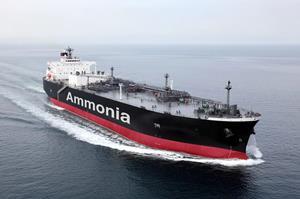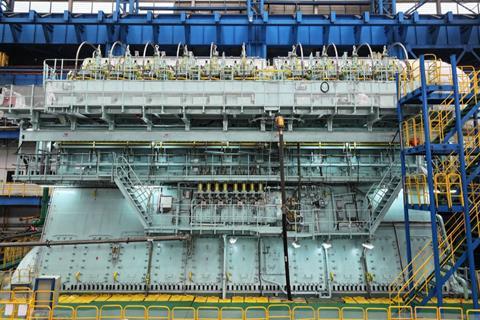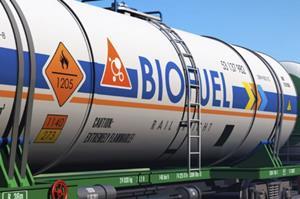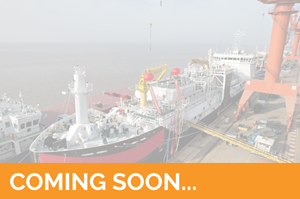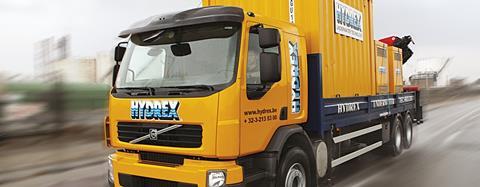On May 16th, 1974, Hydrex was officially born.
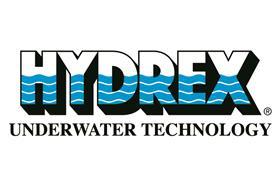
In the 50 years since then the company has grown from a small diving firm operating from a home office into a large underwater maintenance and repair company with a 5,000 m² headquarters in the port of Antwerp.
Hydrex founder and CEO, Boud Van Rompay recalls how it all started with him dropping out of law school. “I wanted to do something that was tangible, that I could touch with my hands, that I could look at with my eyes. Not some theory from a book. It had nothing to do with formal education: I had to find out for myself.”
Underlying principles
“I had a very strong urge to see how things were cooking. How do you do this? Very simple: you go outside,” says Boud who is still very involved in the daily workings at Hydrex. “In my case, I was terribly attracted to anything to do with mountains, glaciers and (underwater) caves. It wasn’t the adventure, but the exploration that fascinated me. The experience of discovering things. I wanted to see what this planet had in store for me.
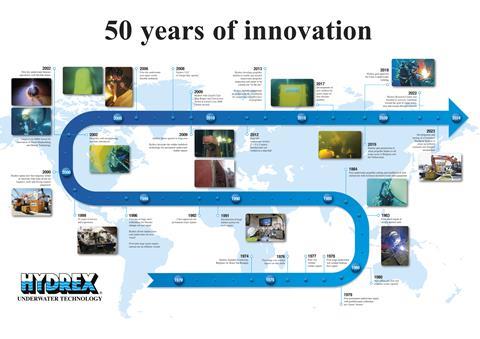
“That’s what made me create the company a couple of years after my mountaineering and caving activities began,” continues Boud. “I saw so much careless handling of water and so much pollution in it, that I said: This is what I need to be involved in – I need to start exploring it further. The first goal was: Clean rivers, seas and oceans. That’s a static goal towards which you can work. The sub-goal or purpose was action oriented: To build expertise with water, which gave us the name Hydrex.”
For Boud this was a very clear-cut purpose. “Expertise is knowing what you are talking about. The first thing to do is to look. You look for yourself, you don’t listen to others or read a pre-cooked book without thinking. I read a lot, but I assessed it against my own observations. This exercise of increasing knowledge leads to an increased responsibility. When you know what you are doing, you can control your actions. This is what an expert does. That is what we have been doing for fifty years, from day one.”
Humble beginnings
“We started working from home, but very rapidly we came to the city,” Boud says. “We rented a small office and one of the warehouses of a ship repair company in Antwerp. That was the start. From day one we had a dedicated training center. In 1980 we built our office in Antwerp at the current location of our headquarters. The warehouse included a dive tank to practice underwater welding and other repair work. I felt we needed to have direct access to the water. The Asiadok was ideal because it looked like a swimming pool. It still has very little traffic fifty years later. This allowed us to do all kinds of experiments. Being located there was part of the urge to discover. You don’t need much water to discover things. You just need to get wet and that’s what we did.
“From that point onwards, there was no stopping us. Hydrex kept expanding and expanding. We were active in Rotterdam and the entirety of the Netherlands from the very beginning. The rest of Europe soon followed. In the ‘80s we went worldwide with our services because the demand was there.
“We simply looked at what ships were doing. Back then when you had a ship in port with a problem – with a condition or defect – it had to go to drydock. We said no, you don’t have to go to drydock. We can repair this in-situ during loading and unloading. It was a very simple conclusion. I had an underwater welding certificate from the start, so we did weld repairs from the early days. If there was work to do, we did it. Together with my team, I looked at any problem thoroughly until we cracked it.”
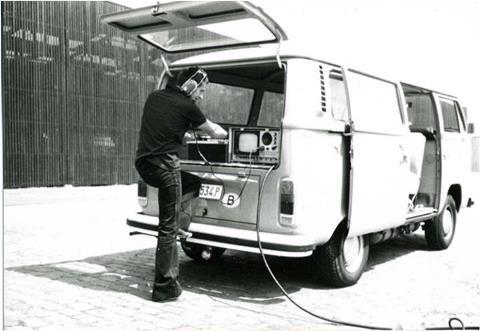
Developing new techniques
Boud remembers the next phase as if it were yesterday. “The next thing was to develop the required techniques. That came very rapidly, from pure observation. How do you fix damage in the shell plating? For permanent repairs you have to be able to work in dry conditions. How do you do this? You use a cofferdam. So we developed the cofferdam. We didn’t know we were the first back then. In 1979 we used our first cofferdam on the general cargo ship Lunar Venture, and that was it. This was the first major repair with no condition of class, no need to drydock the ship for follow-up repairs. Since then, we have built a very large number of cofferdams. In the early ‘90s we had three to five cofferdam interventions per week. This way we kept ships out of drydock very consistently.
“From cofferdams it went into all the variations,” Says Boud. “We adapted diving bells into what we call habitats. Habitats and cofferdams are the key factor in repairing ships underwater. They work very simply: You need to do dry welding or other dry work, so you create a dry environment during the job, whether that’s a stern tube seal, a bow thruster, or a shell plate repair. In the ‘80s we started with propeller blade repairs. We encountered bent propeller blades – propellers that were vibrating and had to go to drydock. We cut the blades to solve this. Later, in 2002, we developed a cold straightening machine.
“For us this was all very simple because we had direct access to the water. We understood the hydrodynamics of what we were doing. This led to a vast range of methods and methodologies with which we fixed ships. Some of these repairs were on a very large scale. We were asked to repair a gash of 100 meters on a ship in Boston in winter and we did not see this as a problem. We just went for it.
“When Hydrex started, proper repairs underwater did not exist. We created the whole gamut of services,” says Boud. “Most of these evolved over a period of thirty years, from 1974 until 2004. By then we were ready to tackle any kind of problem a ship could encounter.”
Continued expansion
As a result of this, Hydrex had grown too big for the existing warehouse at the start of the 21st century. A state-of-the-art fast response center was constructed in 2000 to allow the company to keep providing their customers with the best possible service. By then three dive tanks were available to their divers.
September 2015 saw the start of another large expansion of the Hydrex headquarters in Antwerp. This expansion was the natural consequence of the growth Hydrex had undergone in the last couple of years. New offices and meeting rooms were constructed, and the existing areas were completely refurbished. A totally new workshop was also added to the existing locations and new training facilities were constructed, bringing the total area covered by the premises to over 5,000 m².
Earlier this year, yet another very large warehouse was added to accommodate the constant growing demand for Hydrex services.
The fleet of vans, trucks and workboats have all been recently updated. Today the fast response center is state-of-the-art as far as equipment and vehicles goes, with everything in excellent condition, ready to deliver advanced underwater maintenance and repair services wherever they are needed in the world.
From day one the fleet of vehicles and the equipment was painted in the recognizable yellow we are known for. This was not a random choice explains Boud. “I knew that this particular color was the last one to remain visible. Colors get hazy at sea, they disappear rapidly. Navies color themselves in grey for this reason. It makes a ship disappear. If you want to see anything on the water, you use yellow. Our tint of yellow disappears last. If you enter the port, our yellow vans, trucks, containers are clearly visible, even from a distance. The sun is not always shining, so you have to stand out. There is a safety factor in this as well as brand recognition. We are the first to be seen and the last to disappear.”
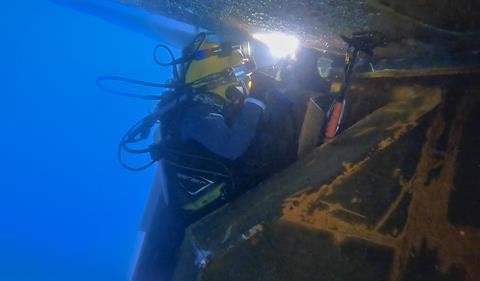
More than a diving company
“From the very beginning we were not just a diving company,” says Boud “We were always finding new technologies to help the customer, often even before he knew he had a problem – before he asked us. We looked at the problems we encountered and found a solution every single time. We have always found new challenges to solve in our area of expertise: underwater ship interventions.
“For example, there is a severe situation with pollution in ports, rivers and estuaries. We developed a system to clean up polluted sediment. A variant of this technology can be used to remove dropped ammunition that was distributed in 700 depots worldwide.
“Because we saw this serious problem with pollution, we knew we had to stop the toxic emission causing it. One of the major sources is the use of heavy metals and other toxic materials to deter biofouling on ships. That’s a well-known phenomenon, as old as ships and boats are. You put them in the water, and they will collect fouling. How do you stop this? There are ways of doing this differently than before because it causes enormous amounts of pollution. At one point hundreds of thousands of tons of toxic materials were leaching into the seas and the oceans and the ports. Each year.
“We have an engineering department that looked into what was going on. They found massive areas of pollution, even in areas far from shipping where you wouldn’t expect it, like estuaries. Animals are dying there, they are not growing, not prospering. We are now looking at how to stop pollution from anti-fouling and other sources. We need to stop emission of unwanted, polluting products or metals.”
The goal remains the same
Boud sees a lot of opportunities for the coming years. “In the immediate future, the super-performing ship will save 30-50% of fuel with the super smooth hull. We are now building and testing new ways to carry out ultra-fast cleaning without the use of divers. Prototypes have been tested and are very promising. This will allow us to clean any ship in less than an hour, even a 400-meter container ship twenty meters deep in the water.
“Everyone agrees that we need to protect hulls against fouling, but what about seas? We have to protect the seas. Water is the biggest commodity on the planet but the least known. Water pollution is the biggest problem we need to solve.
“I can safely say there are big things coming to the shipping and offshore market: better protection, no more pollution, better fuel savings. How to protect steel in the water. Much has been achieved, but there is more to come.”
Passing on the knowledge
Over the years Hydrex has worked in just about every part of the globe, sending highly trained diving teams world-wide to get work done. The company has built up a network of support bases in over 50 countries, enabling them to provide fast service at reasonable costs.
“Our accumulated know-how, skill and experience is one of the main factors that sets us apart from anyone else in the field,” concludes Boud. “It established our reputation. We never fail at our job. We always fulfill our promise. And we will never stop doing this.”


